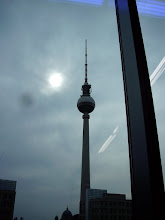Snaking along, cutting through fields and streets, yards and gardens, the 155 km long in total (43 km between West and East Berlin) Berlin Wall stood as a border between East and West Berlin from 1961 to 1989. That all changed on Nov. 9, 1989, when an inexact translation, a confused border guard and a natural longing for a better life opened a hole in that wall that would eventually end the Cold War. Drawn to the city’s historic Brandenburg Tor as word spread on the night of Nov. 9, 1989, both East and West Berliners clambered up the wall and crowded Pariser Platz to take part in the opening. Two years earlier at this spot, Ronald Reagan had implored Mikhail Gorbachev in a speech to “open this gate,” to “tear down this wall.” Today, the entire area around the 18th century landmark gate, just south of the Reichstag building where the German parliament meets, is a pedestrian plaza. The Quadriga, the bronze sculpture atop the Brandenburg Gate, depicts a chariot drawn by four horses and driven by Victoria, the Roman goddess of victory. The horses face east. Visitors used the graffiti-pocked Berlin Wall as a backdrop for souvenir photos along Ebertstrasse, which runs south from the Brandenburg Tor to Potsdamer Platz. Today, Ebertstrasse is the location of the Memorial to the Murdered Jews of Europe as well as the new U.S. Embassy. It was also along this street that Roger Waters of Pink Floyd held an outdoor performance of the rock opera “The Wall” in 1990, eight months after the Berlin Wall fell, for which an estimated 350,000 people gathered. I was there and remember, for my first time in the city, having told myself that I will come back. Now I'm living here ! After the wall was breached, people could view the two sides of Berlin at once for the first time in decades. Here, a photographer straddles the wall looking up toward the Reichstag, where the German parliament convenes, on Nov. 10, 1989, a day after the fall. Today, evidence of the Berlin Wall is embedded in the pavement of streets it once divided; here, a long, double cobblestone line shows the former location of the wall along what is now bustling Ebertstrasse. East German border soldiers and their Klieg lights were trained on the intersection of Zimmerstrasse and Charlottenstrasse, not far from the famous Allied checkpoint Charlie in Friedrichstrasse. By 2009, the corner of Zimmerstrasse and Charlottenstrasse had been completely reconstructed with offices, shops and apartments. Overall, eastern Germany has clawed its way back to a measure of prosperity. The wall cut off the eastern end of the Lohmuehlenbruecke, the bridge over the Neukollner Schifffahrtskanal, leaving the part of the city called Neukoelln in West Berlin and its neighbors in Treptow in East Berlin. Near here, the first watchtower was erected in the so-called “death strip” between the outer and inner walls, and various buildings were razed to give guards a better overview. The border strip, which contained anti-vehicle trenches and other defenses, has been redesigned as a park. There is a possibility soon that a motorway coming in the city will be built nearby but people fight hard against the idea.
Subscribe to:
Post Comments (Atom)


No comments:
Post a Comment